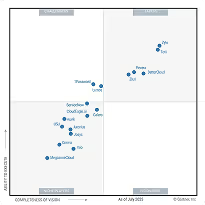HIPAA Compliance Checklist for 2025

The SaaS revolution has completely transformed how modern enterprises operate. From HR to engineering to finance, every department now relies on specialized apps to drive productivity and collaboration.
But as adoption skyrockets, complexity follows close behind. Studies show that the average enterprise uses over 350 SaaS applications, with many running as high as 500 or more.
The challenge? Most of these apps are purchased and managed by different teams without centralized oversight.
This leads to unmonitored app usage, redundant tools performing the same function, unused licenses renewing automatically, and hidden security or compliance risks lurking beneath the surface.
Without unified visibility and control, SaaS sprawl doesn’t just waste money, it creates operational chaos, weakens governance, and exposes enterprises to avoidable risk.
TL;DR
- SaaS sprawl is exploding, with enterprises using 350–500+ apps - most unmanaged, redundant, or underutilized.
- Traditional IT tools can’t keep up with modern SaaS ecosystems because they lack real-time discovery, usage insights, renewal tracking, and governance controls.
- An enterprise-grade SaaS management platform is essential for automated app discovery, spend analytics, license optimization, renewal oversight, and access governance.
- CloudEagle.ai stands out by unifying SaaS visibility, cost optimization, access governance, renewals, and workflow automation—all powered by 500+ integrations and AI-driven intelligence.
- Enterprises save 20–30% annually by consolidating tools, eliminating shadow IT, automating license management, and improving compliance with centralized visibility and control.
What challenges do enterprises face with SaaS sprawl?
SaaS sprawl is no longer a buzzword, it’s a real operational issue. Common pain points include:
- Duplicate tools: Marketing and Sales might both use different CRMs.
- Underused licenses: 40–60% of purchased licenses often go unused.
- Shadow IT: Employees sign up for tools without IT approval.
- Budget waste: Renewals happen automatically without review.
- Compliance blind spots: Sensitive data lives in unapproved apps.
Every untracked app increases costs, weakens governance, and heightens security risks.
Why traditional IT tools can’t handle modern SaaS ecosystems
Legacy IT asset management or spreadsheets worked when software was installed locally. Today, SaaS is dynamic, subscriptions can be started or canceled in minutes. Traditional tools can’t:
- Detect cloud apps automatically
- Track usage or renewals in real-time
- Analyze spend across departments
- Enforce access and compliance policies
That’s why enterprises now adopt dedicated SaaS management platforms (SMPs) — systems built to deliver complete visibility, control, and optimization.
What Makes a Modern SaaS Management Platform?
A SaaS management platform centralizes every aspect of your software ecosystem — discovery, usage, spend, contracts, and access. It gives IT, Finance, and Procurement a shared source of truth.
Key Capabilities You Should Expect
When evaluating a SaaS management or governance platform, it’s important to look beyond surface-level visibility. The right solution should give you complete control over every app, license, contract, and user across your organization. Here’s a deeper look at the core capabilities that define an enterprise-grade SaaS visibility and control platform:
1. Automated App Discovery:
A powerful discovery engine is the foundation of SaaS visibility. It automatically detects every SaaS application being used across your organization including shadow IT that’s often missed by IT and security teams. By integrating with SSO tools, expense systems, and browser extensions, these platforms uncover unmanaged or duplicate apps, ensuring no hidden subscriptions slip through the cracks.
2. Spend Analytics:
Managing SaaS spend goes far beyond tracking invoices. Advanced spend analytics consolidate data from procurement, finance, and IT to provide a 360° view of SaaS expenses. This includes monitoring renewal dates, usage patterns, contract terms, and price escalations. With detailed dashboards, teams can identify where spend is increasing, which apps deliver the most value, and where consolidation opportunities exist.
3. License Utilization Tracking:
Up to 49‑53% of SaaS licenses go unused, leading to wasted spend (for example: one report found organizations wasting ~$21 million annually on idle licenses).
Unused or underused licenses are one of the biggest sources of SaaS waste. License utilization tracking helps teams measure actual adoption and compare it to purchased license counts. By identifying idle seats and over-licensed departments, IT and finance teams can reclaim budget and optimize subscription tiers before renewal cycles.
4. Renewal Automation:
Renewals are easy to overlook and missed reminders often result in auto-renewals for tools no longer in use. Renewal automation ensures you’re always in control by sending timely alerts, reminders, and approval workflows to stakeholders well before the renewal date.
Some platforms even offer centralized renewal calendars and automated negotiation triggers, so you never pay for what you don’t need.
5. Access Governance:
Security and compliance are at the heart of SaaS governance. Access governance capabilities let you manage user permissions across all apps, ensuring employees have only the access they need. Features like role-based access control (RBAC), just-in-time provisioning, and automatic deprovisioning during offboarding reduce insider threats and support a least-privilege security model.
6. Vendor Management:
Keeping track of multiple SaaS vendors can be overwhelming. A robust SaaS management platform acts as a central hub for vendor and contract data, storing renewal terms, pricing details, and points of contact in one place. It simplifies communication during renewals or negotiations and enables procurement teams to track performance and compliance more efficiently.
7. Workflow Automation:
Automation is the key to scaling SaaS management. Workflow automation simplifies repetitive processes such as employee onboarding, offboarding, and license reassignment. It ensures that the right tools are provisioned instantly to new hires while unused licenses are reclaimed when employees exit. This not only boosts operational efficiency but also strengthens security posture.
Together, these capabilities deliver enterprise-wide visibility and control over every SaaS dollar, license, and user. They transform fragmented, manual management into a cohesive, data-driven strategy that helps enterprises cut costs, minimize risk, and maximize value from their SaaS ecosystem.
Top-Rated SaaS Platforms for Enterprise-Wide Visibility and Control
The SaaS management landscape is growing fast, with multiple players offering specialized capabilities. Below are some of the top-rated platforms enterprises rely on to bring order to SaaS chaos.
CloudEagle.ai - Unified SaaS Visibility, Governance, and Cost Optimization
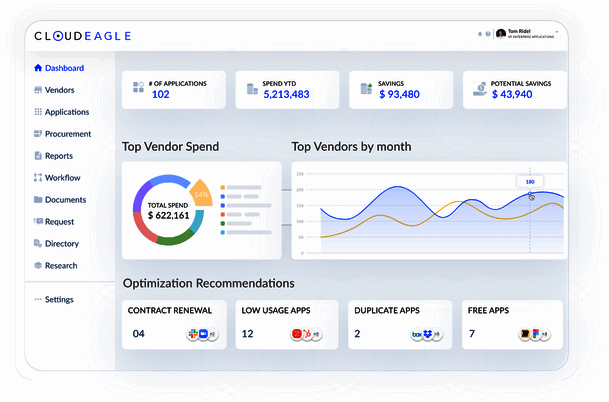
CloudEagle.ai is redefining enterprise SaaS management by combining deep visibility, AI-powered optimization, and workflow automation, all in a single, purpose-built platform. Trusted by IT, Procurement, and Finance leaders at mid-market and enterprise companies, CloudEagle gives you centralized control over every application, license, contract, and vendor from discovery to renewal.
What Makes CloudEagle Stand Out
Discover - Full-Stack SaaS & AI Visibility
- Complete App Discovery: Detects every SaaS and AI app in use, including shadow IT, via integrations with SSO, finance systems, HRIS, and browser data.
- 500+ Native Integrations: Instantly connects with tools like Okta, Azure AD, Netsuite, Coupa, and Ironclad to consolidate application, spend, and contract data.
- Shadow IT Detection: Cross-verifies login and spends data to surface unsanctioned tools and prevent unauthorized access.
Govern - Access & Compliance Automation
- Zero-Touch Provisioning/Deprovisioning: Automates app access based on role, department, or location, with no dependency on IDP-only tools.
- SOC2-Ready Access Reviews: Streamlines periodic reviews with auto-generated user access reports and workflow-based approval cycles.
- Role-Based App Catalog: Enables secure employee self-service while ensuring least-privilege access.
- Time-Based Access Controls: Grants and auto-revokes temporary access for contractors or high-risk roles.
Renew - Proactive Renewal Management & Negotiation
- Smart Renewal Calendar: Flags upcoming renewals and centralizes contract metadata, including notice periods, opt-outs, and SKUs, using AI extraction.
- Price Benchmarking & Vendor Insights: Leverages crowdsourced and platform-driven benchmarks to support smarter negotiations.
- Workflow-Driven Approvals: Automates intake-to-procure and renewal cycles with Slack-enabled workflows that cut approval delays.
Optimize - SaaS Spend Reduction with AI
- License Harvesting Engine: Identifies unused or underutilized licenses across apps and automates downgrade, removal, or reallocation.
- Feature-Level Usage Tracking: Goes beyond logins to analyze actual feature adoption, ensuring you’re paying for what’s being used.
- Duplicate App Rationalization: Uses AI to detect overlapping tools and consolidates them, reducing SaaS sprawl and budget leakage.
- Real-Time ROI Dashboards: Offers finance and procurement teams granular insights into spend, renewal timing, and savings opportunities.
The CloudEagle Edge:
Unlike point tools that focus on either discovery or procurement, CloudEagle combines both. Enterprises can track all SaaS apps, manage vendors, automate renewals, and negotiate savings — all within one platform.
Real business impact:
- Reduce SaaS costs by 20–30% annually.
- Reclaim hundreds of unused licenses.
- Eliminate shadow IT and compliance risks.
- Give every stakeholder real-time visibility and accountability.
By bridging visibility, governance, and cost optimization, CloudEagle helps enterprises scale their SaaS ecosystem securely and efficiently.
Productiv – Comprehensive SaaS Optimization and Insights

Overview:
Productiv is a key player in the SaaS management space, focusing on providing detailed usage insights, spend optimization, and IT operational visibility. It serves enterprise IT and procurement teams with data to optimize software spend and usage.
Strengths:
- Strong focus on SaaS optimization.
- Provides deep data and insights into SaaS usage and spend.
- Rich integration capabilities with enterprise systems.
Limitations:
Less focus on access governance and user lifecycle management, which may leave gaps in security and compliance.
Pricing:
According to their website, Productiv lists no fixed tiered pricing; the call to action is “Get a Demo.
Cledara – End-to-End SaaS Management and Procurement
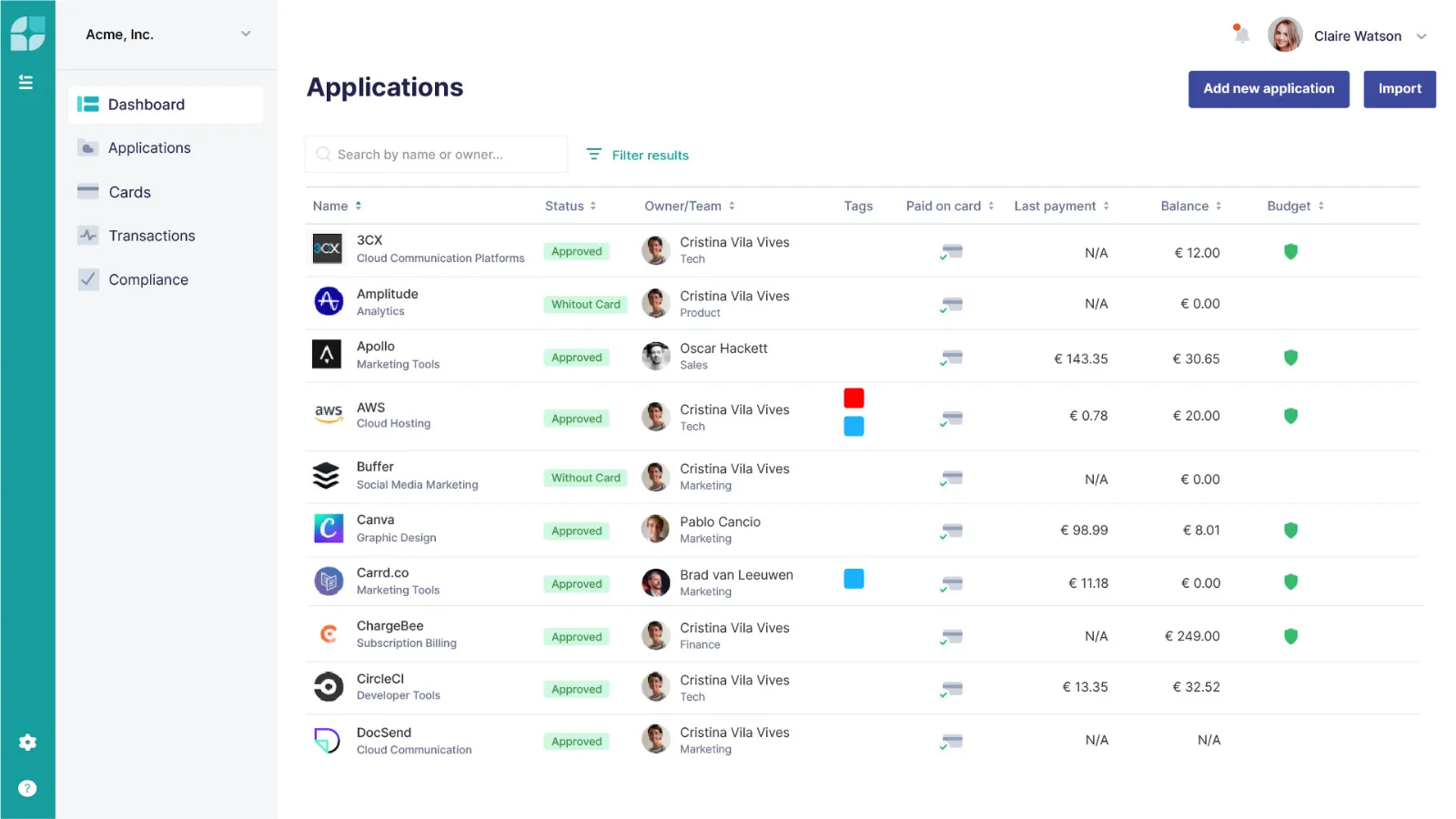
44Cledara offers a solution for procurement, management, and optimization of SaaS subscriptions. It targets both financial and operational stakeholders, offering tools for purchase, payment, and management of SaaS tools.
Strengths:
- Strong spend management and procurement capabilities.
- Well-suited for cross-functional teams, including finance, procurement, and IT.
- Simplifies SaaS vendor relationships and financial management.
Limitations:
Lacks comprehensive access governance and user lifecycle automation.
Pricing:
Cledara lists tiered plans:
- Basic: US $75 / month (or equivalent) for smaller teams managing up to ~20 apps.
- Premium: US $200 / month (typically up to ~75 apps).
- Pro: Starts at US $500+ / month, custom pricing for larger enterprises.
BetterCloud — IT Automation and Access Control Workflows
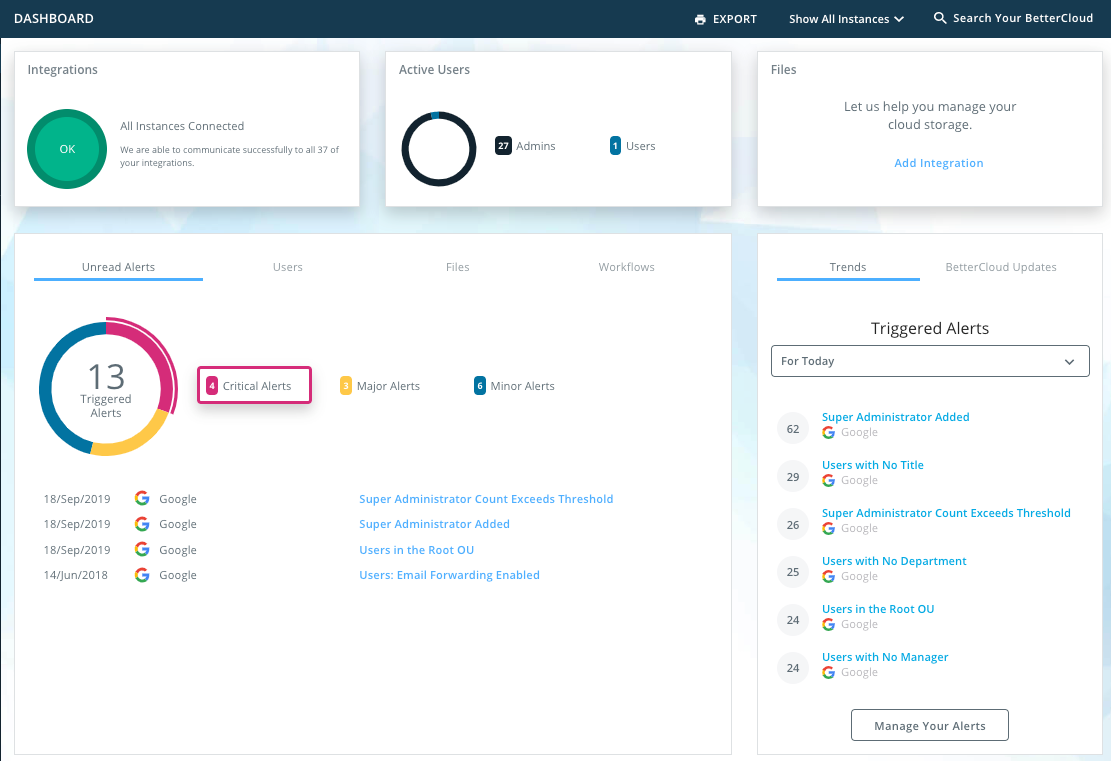
BetterCloud is an IT-focused SaaS operations and security platform built to automate user lifecycle management and enforce access controls. It’s best suited for organizations prioritizing security, compliance, and identity governance across a distributed SaaS environment.
Features:
- Automated provisioning and deprovisioning workflows.
- Granular access control and policy enforcement.
- Security automation and audit-ready governance features.
Limitations:
- Minimal spend visibility or cost optimization features.
- Primarily focused on IT workflows, not procurement or finance.
- May require technical setup for integrations and policies.
Pricing:
- Subscription-based pricing that scales with organization size and features.
- Enterprise plans available for large, security-driven teams.
- Pricing shared upon request; no public tiers.
Spendflo — Procurement and Vendor Alignment
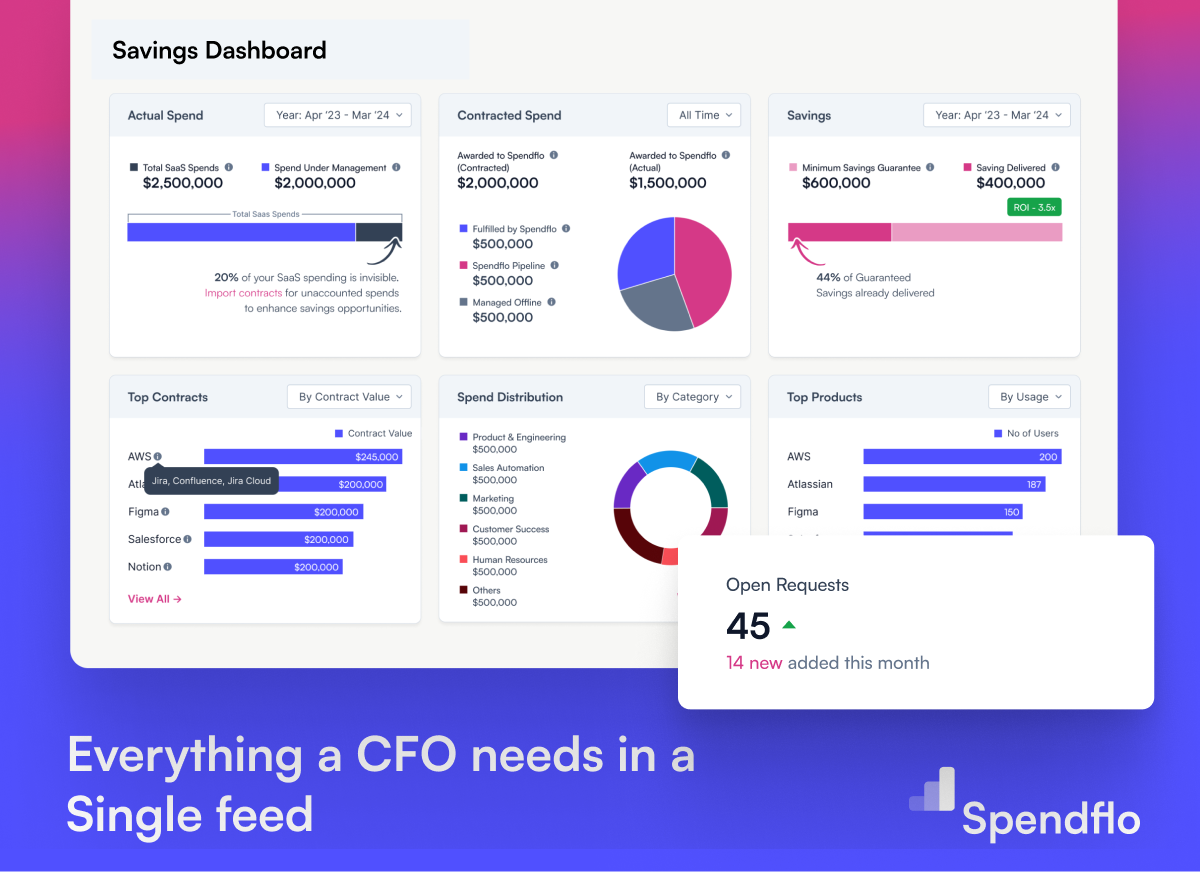
Spendflo is a procurement-driven SaaS management solution that merges spend optimization with vendor relationship management. It helps organizations track contracts, manage renewals, and benchmark vendor pricing, making it a favorite for finance and procurement teams focused on savings.
Features:
- Centralized vendor and contract management dashboard.
- Renewal alerts, negotiation workflows, and spend analytics.
- Vendor benchmarking and procurement performance insights.
Limitations:
- Limited access control or IT automation features.
- Focused primarily on financial optimization over technical visibility.
- Usage insights less detailed than IT-focused platforms like Zluri.
Pricing:
- Flexible, ROI-based pricing tailored to procurement volume.
- Plans available for startups, mid-market, and enterprises.
- Transparent demo-based consultation for pricing details.
How to Choose the Right SaaS Management Platform
With multiple options available, the right fit depends on your organization’s goals — whether that’s cost control, automation, or governance.
Key evaluation criteria:
- Integration depth: Does it connect with your identity, finance, and HR systems?
- Scalability: Can it handle multiple entities and thousands of users?
- Usability: Is it intuitive for cross-functional teams to adopt?
- Analytics & Reporting: Are insights actionable and real-time?
- Automation: Can it reduce manual workload and prevent missed renewals?
- Implementation support: How quickly can it be deployed and onboarded?
For example, CloudEagle.ai’s guided onboarding and extensive integrations make deployment frictionless - typically within weeks, not months.
Benefits of SaaS Visibility and Control Platforms
Enterprises that invest in SaaS visibility and control see tangible returns across cost, security, and operational efficiency.
1. Reduce SaaS Costs by 20–30%
- Identify redundant or duplicate tools.
- Reclaim unused licenses and downgrade idle plans.
- Consolidate vendors for better volume pricing.
2. Improve Compliance and Data Security
- Centralize app and access visibility.
- Automatically revoke access when users leave.
- Maintain audit trails for governance and security audits.
3. Empower Cross-Functional Collaboration
- IT controls access and integrations.
- Finance gains real-time spend data.
- Procurement manages renewals and negotiations.
When everyone operates from a single source of truth, software decisions become strategic instead of reactive.
The Future of SaaS Governance: Centralized, Automated, and Intelligent
SaaS management is entering its next phase where AI, automation, and collaboration merge. Enterprises can no longer afford manual tracking or disconnected processes.
The future belongs to organizations that:
- Centralize their SaaS stack under unified governance.
- Automate renewals, audits, and license management.
- Use AI-driven insights to optimize spending continuously.
Final Thought:
In today’s SaaS-first world, visibility and control aren’t optional, they’re essential. Organizations need to move beyond just tracking their software stack to actively governing and optimizing it for maximum value.
CloudEagle.ai empowers organizations to discover their entire SaaS portfolio, govern access and usage with precision, renew contracts proactively, and optimize software spend through AI-powered insights.
By integrating 500+ SaaS platforms and supporting AI-driven automation, CloudEagle.ai helps IT, finance, and procurement teams achieve 10–30% savings, improve compliance, and streamline license management.
In a world where every department is reliant on SaaS tools, CloudEagle.ai is the partner enterprises can trust to scale confidently while driving down risk and costs. It’s not just about managing software, it's about turning it into a strategic asset that supports growth, drives efficiencies, and ensures governance at every level.
FAQs
What is a SaaS visibility and control platform?
A SaaS visibility and control platform helps enterprises monitor, manage, and optimize their entire SaaS stack, offering real-time insight into app usage, spend, and governance across all departments.
Why do enterprises need SaaS management platforms?
Large organizations use hundreds of SaaS apps, often without centralized control. SaaS management platforms help eliminate shadow IT, reduce redundant tools, and ensure compliance while lowering operational costs.
How do SaaS optimization tools improve visibility and reduce costs?
They automatically track licenses, detect underused apps, and consolidate spending data. By reclaiming idle subscriptions and negotiating better vendor terms, enterprises save 10–30% annually.
What features should I look for in a SaaS governance solution?
Look for automated discovery, contract management, renewal tracking, access governance, spend analytics, and integration with SSO, finance, and HR systems for complete visibility.
Which platform offers the best visibility and control for enterprises?
Platforms like CloudEagle, Zylo, and Zluri lead the market. CloudEagle stands out for combining AI-driven insights, renewal automation, and 500+ integrations tailored for mid-market and enterprise governance.

%201.svg)







.avif)




.avif)
.avif)




.png)
